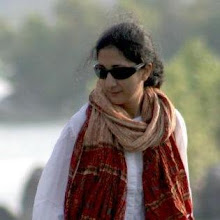
The God fearing, somber precincts of Raghurajpur, a palm tree lined heritage village, 10 kms from Puri took me by surprise when, upon my arrival I spotted pint sized, top knotted dynamites, running riot across the village road, with their pranks. Normally, such pranks would command instant punishment by the village elders, but here was an exception. These boys are, I was told, “God’s Children” who perform Gotipua dance. Hence, everyone puts up with them. These boys are exclusively chosen by the community to please Gods. They powder their face, paint their eyes and forehead, grow their hair and dress up like girls. They are the female devotee dancers – consorts of Lord Krishna – the GOTIPUA DANCERS..
Gotipua, in Oriya means “Goti”, single and “pua”, boy. This is a dance tradition as old as 300 years old where a single boy used to dance for lord Krishna. It is the mainspring of the now famous classical Odissi dance. Raghurajpur has given birth to not only the Gotipua tradition, but also legendry dancers like Guru Kellucharan Mahapatra and Guru Maguni Charan Das. The dance is still practiced in the village in Guru Maguni Das’ gurukul ashram Dasabhuja Gotipua Odishi Nrutya Parishad. Boys are recruited at the age of about six and perform till their voice begins to crack and the first glimpse of peach fuzz appears. They live in the ashram, maintaining a very strict discipline, which starts at four o’clock every morning with oil massage, stretching, bending and twisting the limbs, followed with their abhyas. Ashram also takes care of their formal education. Once they leave the Ashram, many of the boys continue as dancers or become musicians.
There are various reasons put forth to explain the origin of Gotipua dance. All theories however date this tradition back to 16th century. According to some, when a section of Vaishnav preachers did not approve of maharis (devadasis), women dancing in the temples as the pretext of worship, they introduced the practice of dancing by boys dressed up as girls. As narrated by Guru Maguni Das, in twenty one days long Chandan Yatra of Puri, Swami Chaitanya the great vaishnav saint wanted to perform the dance in the procession of Lord Jagannath and Lord Shiva. Priests objected to this, as the devadasis had to interrupt the dance during their menstrual period. That’s when boys of tender age were brought in to perform the devadasi’s dance. It was around this time that Orissa was also under going socio-political turmoil as its last dynasty had collapsed and mughals and Afghans were trying for a hold on the state. At this time, akhadas were made to shelter gotipua, where boys were groomed as fine dancers as well as fighters to protect the temples of Orissa. Embellished in customary feminine costumes, Gotipua dancers possessed the feminine glow and lucidity as well as the masculine valor and vigor to protect the temples from intruders.
From 17th century onwards Gotipua dance spread as a temple culture and was performed regularly in Lord Jagannath temple in Puri. The journey of Gotipuas from the village temples to the metropolitan theatres within India and across the globe has been a long one but successfully spanned. A major credit for this goes to Guru Maguni Charan Das who has dedicated 65 years of his life not only to keep the tradition alive, but also taken it to places. Under his tutelage, this tradition has taken a theatrical form, where from one boy the dance is now performed by a group of boys, and accompanied by musicians who play mirdala, harmonium, cymbals, flute and violin. One can catch a glimpse of these little boys dancing in the ashram, early in the morning.
Gotipua truly is a great dance tradition which celebrates the reunion of man with the Divinity. Such is the beauty and allure of the dance that even Gods are said to revel in it!


No comments:
Post a Comment